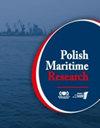船用柴油机应用中的数字孪管试验台性能
IF 2
3区 工程技术
Q2 ENGINEERING, MARINE
引用次数: 0
摘要
摘要 数字孪生系统的应用是提高船用发电厂运行效率的一个前景广阔的解决方案,尤其是其重要组成部分--船用内燃机(ICE)。这项工作介绍了应用性能数字孪生系统监测船用内燃机技术状况和诊断故障的概念,以及该概念在基于船用柴油发电机的实验台架上的实施情况。实施这一概念的主要原则涉及从安装在发动机上的传感器到服务器的数据传输技术。数字孪生系统也在服务器上运行,用于自动处理获取的实验数据,积累统计数据,确定发动机当前的技术状态,识别可能出现的故障,并就操作程序的更改做出决策。数字孪生系统的核心要素是船用柴油机运行周期的数学模型。在开发过程中,由于燃烧过程对发动机的燃油效率和废气中有毒物质的排放水平有重大影响,因此对燃料燃烧模型的改进受到了极大关注。增强型模型与基础模型不同,它考虑了燃料喷射过程中平均液滴直径的可变值。如图所示,这对燃料蒸发、燃烧和有毒成分的形成有很大影响。以柴油发动机在 27 种工作模式下的测试结果校准模型为例,证明应用改进的燃烧模型可以更好地根据实验数据调整数字双胞胎,从而实现与真实发动机更精确的对应。本文章由计算机程序翻译,如有差异,请以英文原文为准。
Digital Twin Test-Bench Performance for Marine Diesel Engine Applications
Abstract The application of Digital Twins is a promising solution for enhancing the efficiency of marine power plant operation, particularly their important components – marine internal combustion engines (ICE). This work presents the concept of applying a Performance Digital Twin for monitoring the technical condition and diagnosing malfunctions of marine ICE, along with its implementation on an experimental test-bench, based on a marine diesel-generator. The main principles of implementing this concept involve data transmission technologies, from the sensors installed on the engine to a server. The Digital Twin, also operating on the server, is used to automatically process the acquired experimental data, accumulate statistics, determine the current technical state of the engine, identify possible malfunctions, and make decisions regarding changes in operating programs. The core element of the Digital Twin is a mathematical model of the marine diesel engine’s operating cycle. In its development, significant attention was devoted to refining the fuel combustion model, as the combustion processes significantly impact both the engine’s fuel efficiency and the level of toxic emissions of exhaust gases. The enhanced model differs from the base model, by considering the variable value of the average droplets’ diameter during fuel injection. This influence on fuel vapourisation, combustion, and the formation of toxic components is substantial, as shown. Using the example of calibrating the model to the test results of a diesel engine under 27 operating modes, it is demonstrated that the application of the improved combustion model allows better adjustment of the Digital Twin to experimental data, thus achieving a more accurate correspondence to a real engine.
求助全文
通过发布文献求助,成功后即可免费获取论文全文。
去求助
来源期刊

Polish Maritime Research
工程技术-工程:海洋
CiteScore
3.70
自引率
45.00%
发文量
20
审稿时长
>12 weeks
期刊介绍:
The scope of the journal covers selected issues related to all phases of product lifecycle and corresponding technologies for offshore floating and fixed structures and their components.
All researchers are invited to submit their original papers for peer review and publications related to methods of the design; production and manufacturing; maintenance and operational processes of such technical items as:
all types of vessels and their equipment,
fixed and floating offshore units and their components,
autonomous underwater vehicle (AUV) and remotely operated vehicle (ROV).
We welcome submissions from these fields in the following technical topics:
ship hydrodynamics: buoyancy and stability; ship resistance and propulsion, etc.,
structural integrity of ship and offshore unit structures: materials; welding; fatigue and fracture, etc.,
marine equipment: ship and offshore unit power plants: overboarding equipment; etc.
 求助内容:
求助内容: 应助结果提醒方式:
应助结果提醒方式:


